ISSN ONLINE(2278-8875) PRINT (2320-3765)
ISSN ONLINE(2278-8875) PRINT (2320-3765)
| N.Vijaysimha1 , P.Suman Pramod Kumar2 Assistant Professor , Dept. of EEE, CR.Engineering College, Tirupati, India |
| Related article at Pubmed, Scholar Google |
Visit for more related articles at International Journal of Advanced Research in Electrical, Electronics and Instrumentation Engineering
This paper is to develop a program to determine the required shunt and series compensation on an EHV long transmission line and after which, conduct a power system analysis using a power system simulation package to evaluate the effect of compensations on the line with, To deter mine the shunt compensation at the load end to maintain the load voltage at a fixed percentage of the sending-end voltage, the maximum power transfer limit that may be transmitted under different conditions and to investigate the influence of various factors such as the line length, load power factor and the degree of series compensation on the maximum power transfer capability. This paper will commence with an overview of the problems encountered with an EHV long transmission line. This is followed up by a literature review that covers the research of useful background theories. The results from the performed studies and simulations will also be discussed in details.Finally, this paper will end with a conclusion of and recommendations for future work in this area of research.
Keywords |
| Shunt compensation,Series Compensation,Transmission lines,Voltage,Power. |
INTRODUCTION |
| The continuous increase of the voltage of transmission, line lengths and number of sub-conductors per bundle has emphasized the importance of the excessive line MVAR in EHV systems as well as the associated voltage and reactive controls. During line- charging volt-amperes of a line which have exceeded the inductive vars consumed and operation at light loads, there is an undesirable voltage rises along the line. This voltage rise in turn demands a much higher insulation level, which poses a great problem for the capacitive generator. Moreover, the problem is further deteriorated when the var is necessary to flow to its maximum, causes transmission losses and take up equipment rating. It has been proven that by using the series and shunt compensations are the best available methods because the transmission distance can be reduced artificially and hence, more power can be transferred. The increase in the interconnections of Extra High Voltage (EHV) systems with the increased demand for electrical power has elevated concerns about system security and reliability. |
SERIES COMPENSATION |
| There are two methods to achieve the increase in the maximum power transfer limit of the line. The first method is to increase the transmission voltages. However, this will lead to an accumulating effect of cost increases in the generator. The second method is by reducing the characteristic impedance of the line. The reduction of the characteristic impedance of the line can be achieved either by changing the line dimensions or by addition of capacitors in series with the line. The line dimensions cannot be changed widely and it only creates a small impact on the characteristic impedance value. Therefore, the addition of capacitors in series with the line, also known as the series compensation, is the best available method to reduce the characteristic impedance of the line, the percentage of series compensation and the optimum location of series compensation will be studied. However, the overview on the types of series capacitors, which could result in improving the system stability |
 |
| In Fig 1, a transmission line is divided into 10 equal sections and an equivalent π model represents each section. A lumped compensation can be placed at any locations marked 1 to 11 and a distributed compensation consists of splitting the compensation from a range of locations, for example, from location 4 to 8 or location 1 to 11. In comparison between these two types of series compensation, a lumped compensation gives a better result than a distributed compensation from the point of view of obtaining the maximum power transfer, if the compensation is distributed, splitting of the compensation into five equal parts and locating them at 30%, 40%, 50%, 60% and 70% of the line length from receiving end, obtain the best results . To determine the required series capacitor in the transmission line of different degree of series compensation, the value of Ks=40% and Ks=75% can be computed into a program function called series compensation (ABCD), which is taken from . The results of the computation are shown below. |
A. Percentage Compensation (Ks) |
| The percentage or the degree of series compensation is used to analyse a transmission line with the required addition of series capacitor s. It is defined as the fraction of Xc, which refers to the total capacitive reactance of series compensators and Xl , which refers to the total inductive reactance of the line, as. KS=XC/ Xl .Since the objective is to determine the amount of series capacitor on the line, it will therefore be useful to define the degree of compensation (Ks) in the total line impedance, which is Z=R+j [Xl (1- KS) |
B. Effect of Location of Compensation |
| The identification of the optimum location of the series compensation on the line is very important because compensation at this location has been proven that it could obtain more economical loading and results in minimum loss of revenue to the supply utility and minimum rise in receiving end voltage |
C.Performance of series capacitor-compensation under under-frequency conditions |
| Due to the lack of sufficient generating capability in developing countries, the implementation of an under-frequency operation of the power system is accepted as a Strategy for maintaining the continuity of supply. This is due to the fact that the Subnormal frequency operation is associated with the reduced load demand, taking into Consideration of the frequencydependent characteristics of load. |
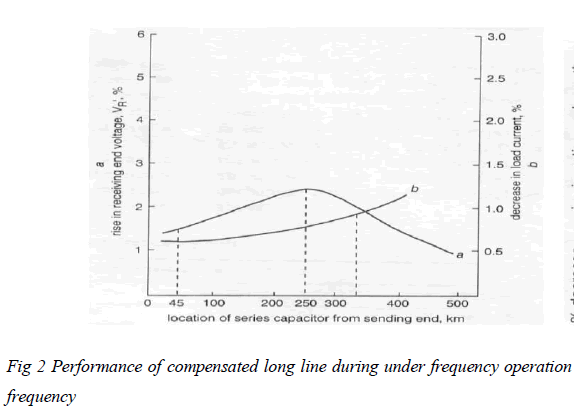 |
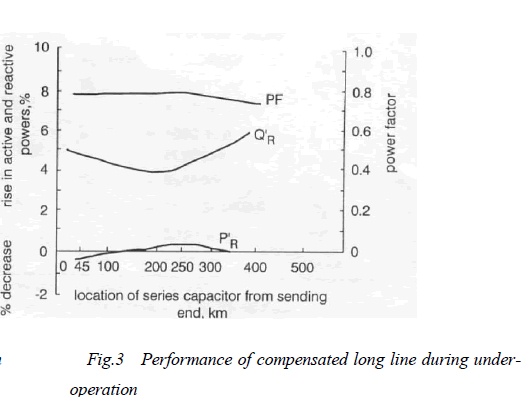 |
| In Fig.2, it shows the result of an uncompensated line, b and a compensated line, during under-frequency operation over a distance of 500km. The series capacitor located at the midpoint of the line may be objectionable from an over voltage hazard point of view. For achieving maximum economy, the best location for a series capacitor is at 45km from the sending end of a 500kV, 500km long transmission .Fig.3 illustrates the evaluation of compensation with the changed power factor of system load, current delivered, active and reactive powers transfer red. At 45km from the sending end of line retains the advantage of rise in active power transferred and maximum decrease in sendingend cur rent during normal frequency operation. |
D.The Best Location and Percentage Compensation |
| For developing generalized curves to determining the best location and percentage of series compensation, several lines which are specified by the values of R/XL and l/YXL, are used for studies. The best percentages and locations of series compensation for these lines are shown in Fig 3.5 and Fig3.6. These two general curves are useful in determining the best location and percentage series compensation of any transmission line of length about 1000km for maximum power transfer. |
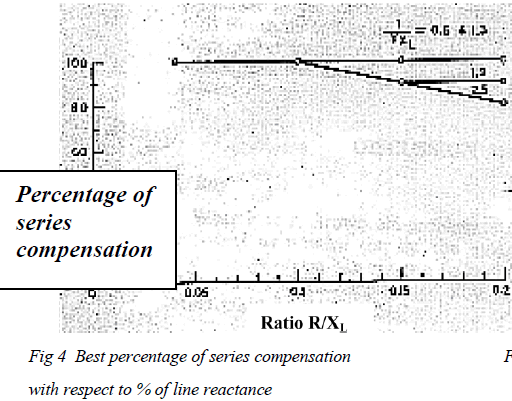 |
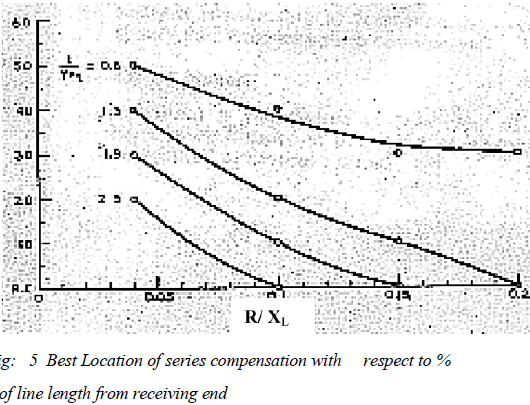 |
SHUNT COMPENSATION |
| Shunt reactors with their compensating effect on the capacitive generation of the line offer an economical and technically sound means of controlling the undesirable over-voltage. This chapter will focus mainly on the overvoltages under steady state condition and the effect of shunt reactors on such over-voltages. In many investigations of determining the maximum power transfer, the amount of shunt reactors required on the transmission line is defined as the degree of shunt compensation (Kd), where Kd=B/Im{y}l Kd is defined as the action of the total inductive susceptance of shunt compensation, B and the total charging susceptance of line Im{y}l Regardless of where the point of maximum voltage (with reactor) is located, the reactor mounted at the middle (point of maximum voltage without reactor) of the line requires minimum reactor rating to bring the maximum voltage on the line within limit.When the reactor (Y pu) is mounted at the middle of the line, the point of the middle voltage is no longer the centre of the line, as shown in Fig 6. Under no-load condition, the reactor mounted at the line terminals has absolutely no control on the voltage profile along the line under no-load condition |
A.Shunt Capacitive Compensation |
| In order to avoid the phenomenon of SSR, some utilities have considered the use of shunt capacitive compensation as an alternative means of increasing transmission capacity.One advantage claimed by shunt capacitive compensation is that it is possible to maintain nodal voltage at nominal value through injection of reactive power along the line. Another advantage is its capability to extend the steady state stability and improve dimpling when used in conjunction with static VAR controllers. |
B. Electrical System Model |
| Given the receiving-end voltage (VR), sending-end voltage (VS), real power (PR) and reactive power (QR) at the receiving end of the line, the required capacitor Mvar at the receiving end for a specified load can be easily computed. The Mvar value of the capacitor can be obtained by the definition given below Mvar=V2/Xc |
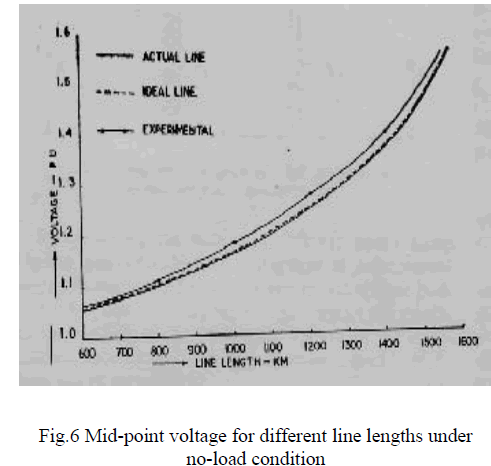 |
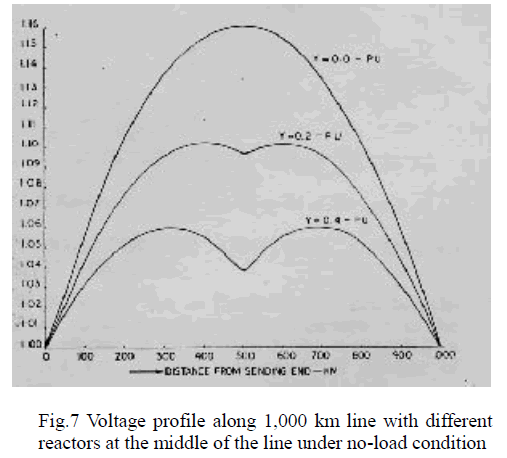 |
EXAMPLE: |
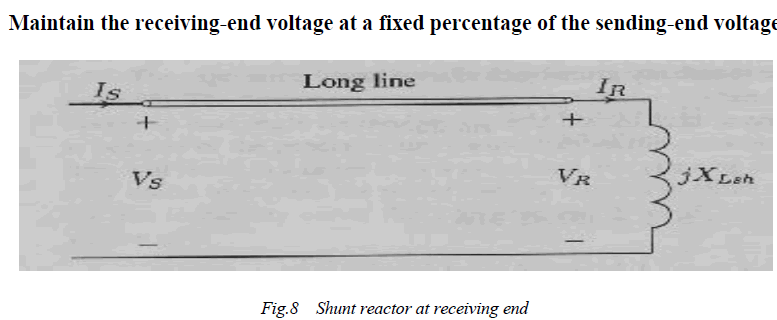 |
| This simple circuit can be used to find the amount of shunt reactor to maintain the receiving end voltage at a specified value. With one reactor only at the receiving end, The voltage profile will not be uniform and the maximum rises occurs at the midspan And the cur rent at the midspan is zero. This is illustrated in Fig 9. |
C.Effect of Shunt and Series Compensations on Maximum Power Transfer |
| With the interconnection of power stations into power systems and power systems into power pools, transmission lines should be capable of transmitting the maximum Possible energy when demanded. By using the series and shunt compensations, the transmission distance can be reduced artificially and hence more power can be transferred. These compensations are necessary to maintain a satisfactory voltage level when large block of power is transferred over a long distance |
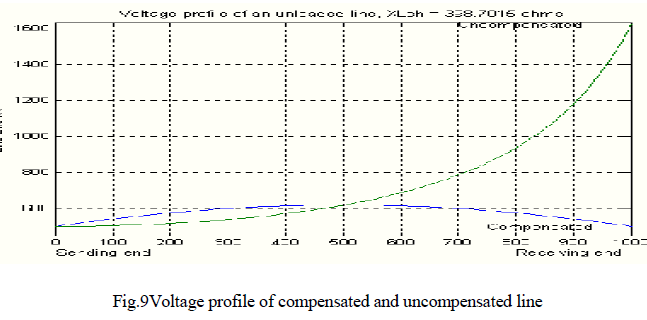 |
.D.Transfer of Power on a long EHV transmission |
| Since a transmission line is operated with sources at both ends of the line, power can be derived in terms of ABCD constants. Since A and B constants are related with the sending- end voltage(Vs ) and receiving-end voltage(VR), the relationship could be expressed as |
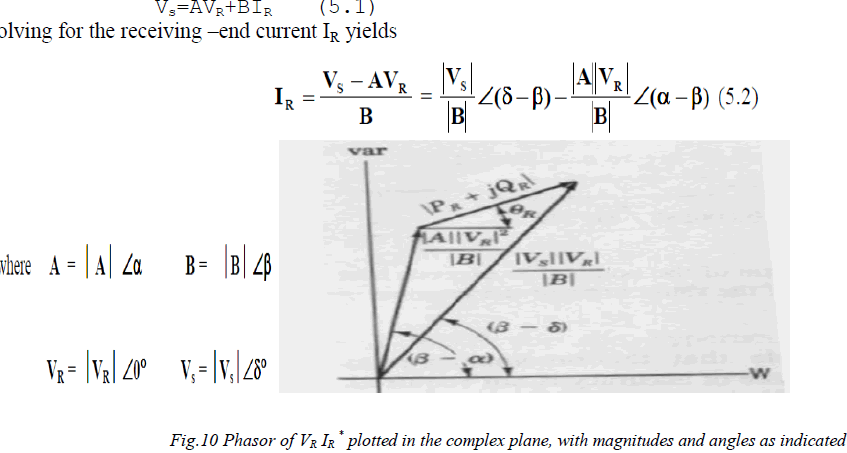 |
| Fig.5.1 shows the two complex quantities and their difference can be solved by the complex power VRIR* and thus the real and reactive power at the receiving end respectively are written as |
 |
E.Classification of system buses |
| Slack bus makes up the difference between the scheduled loads and generated power that is caused by the losses in the network. Load buses and regulated buses are also known as PQ buses and PV buses respectively. The unknown and specified quantities of each bus is summarised in the table below. |
 |
F.Determine the Maximum Power Transfer |
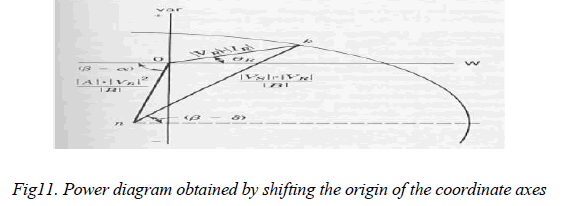 |
| Fig. 11 shows that there is a limit to the power that can be transmitted to the receiving end of the line for specified magnitudes of sending-end and receiving-end voltages. It is worth noting that as point K moves along the arc towards until the angle δ=β, more power is delivered. As δ increases, the lesser power is received. Hence, the maximum power is |
 |
G. Determine the Critical Quantities |
| There are several ways to determine the maximum value of the receiving end Power, P R,cri from the basic formula of receiving end power power which is given by |
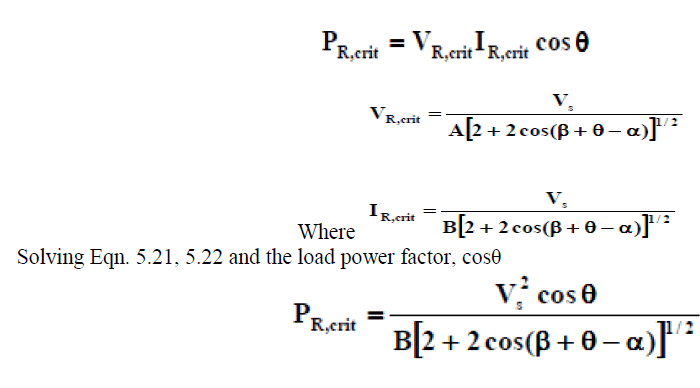 |
Test Systems |
| In this paper two test systems are considered for load flow analysis viz., IEEE 14 Bus System and 30 Bus System. |
14-BUS SYSTEM |
| From the information retrieved from the bus data of the 14-Bus System, Bus 2 is known to be the slack bus and only Bus 9 has a shunt susceptance at the load end. Since the investigation of this thesis is restricted to compensation at the receiving end of the line, therefore Bus 9 will be assumed to be the receiving-end system. The sending-end systems that are connected to Bus 9 are namely Bus 10, Bus 4, Bus 7 and Bus 14. These transmission lines that are connected to Bus 9 are selected for evaluation |
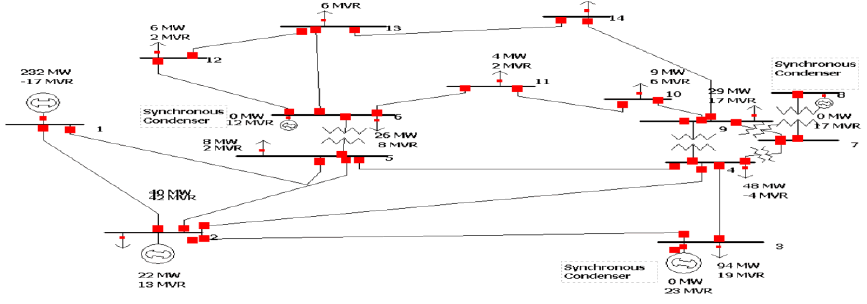 |
IEEE 30 BUS SYSTEM |
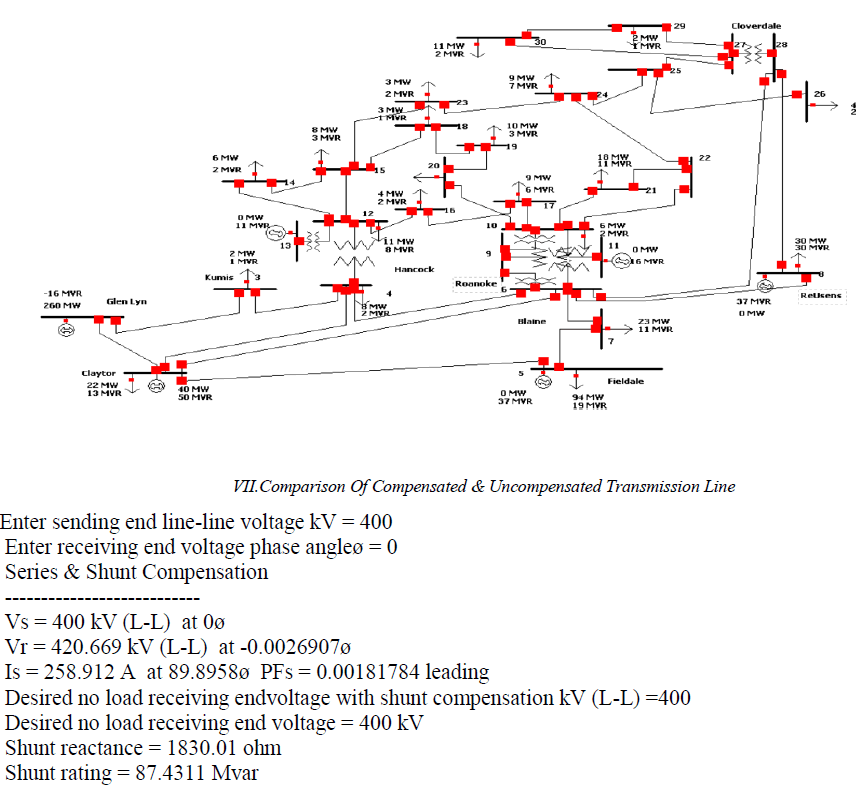 |
CONCLUSION |
| The comprehensive literature review has successfully covered the three main elements of the thesis, which comprise of the long EHV transmission line, the shunt compensation and the series compensation. From the background theories of these three elements, the optimum method of achieving the maximum power transfer in a power system can be deter mined. The two modules of the thesis have emphasized on the ability of the shunt and series compensation on a long transmission line. From the 14-Bus system and 30-Bus Systems, the results show how influential the degree of series compensation (Ks) has on the power transfer capability. With the shunt compensation at the receiving end, the load end voltage can be maintained at a percentage of the sending end voltage. Similar results were obtained from the 14-Bus System and 30-Bus System. Therefore, one can say that the effect of shunt and series compensation is universal on any system, regardless of how massive the power system design is. However, an extensively huge power system will demand for more compensation schemes and the cost of the line will be enormous In conclusion, the shunt compensation at the load end reduces the problem of over-voltages. |
OUTPUT GRAPHS |
| Comparison between Compensated and Uncompensated Line Required shunt compensation |
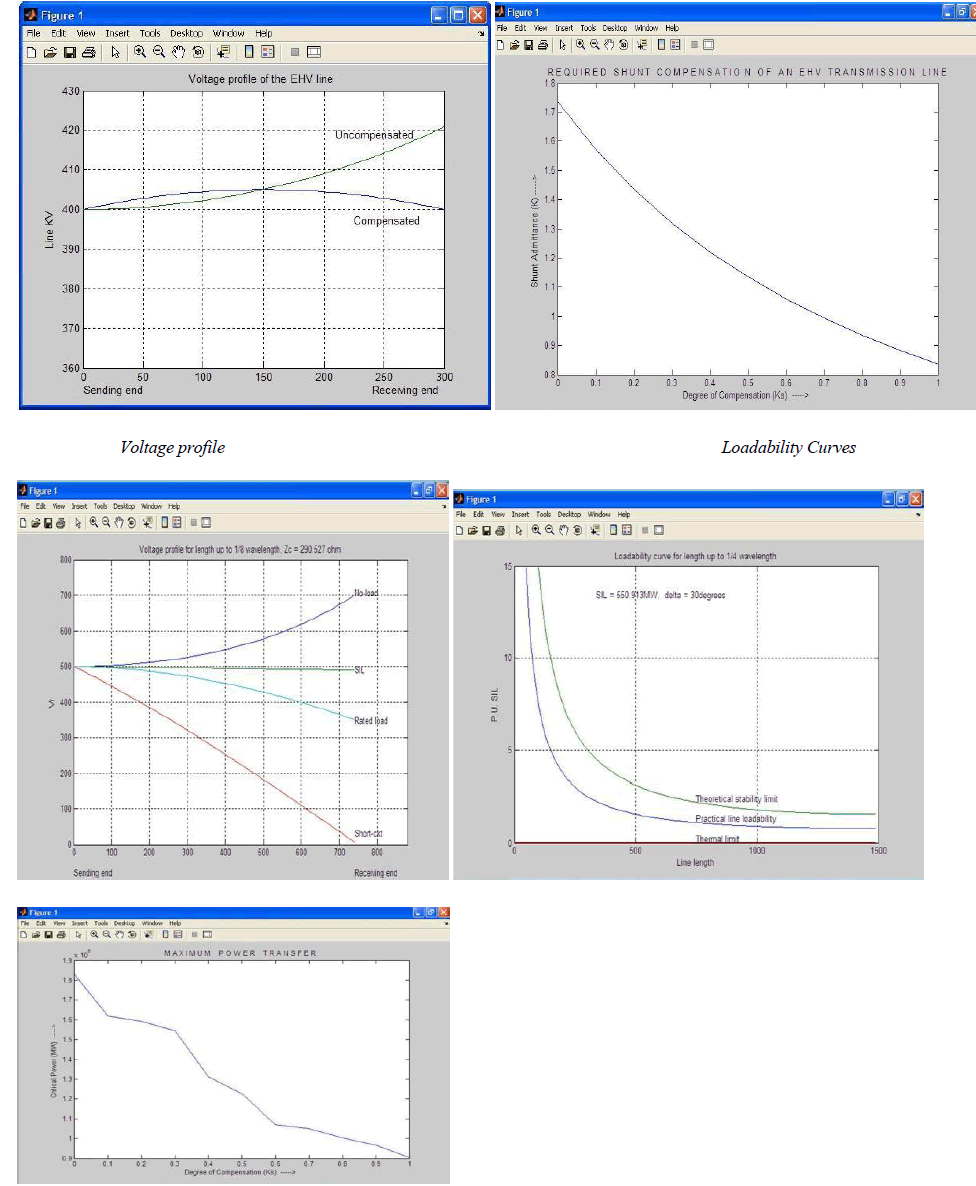 |
| graph b/n critical power and degree of series compensation |
References |
|